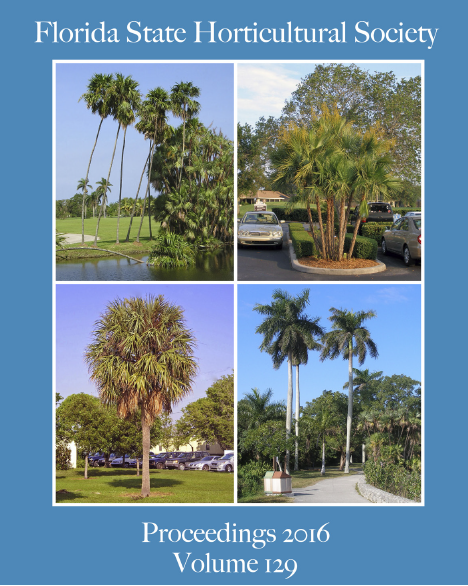Importance of Early Season Copper Sprays for Protection of Hamlin Orange Fruit Against Citrus Canker Infection and Premature Fruit Drop
Abstract
Proper timing of copper sprays for protection of citrus fruit from infection by Xanthomonas citri subsp. citri, the cause of citrus canker, is important because early season lesions induce premature fruit drop. The objective of the trials reported herein was to evaluate early season sprays of copper for control of fruit infection and drop in 3- to 5-year-old Citrus sinensis ‘Hamlin’ trees in a south central Florida citrus grove. Soluble and fixed copper formulations were applied with an airblast sprayer at 21-day intervals. In 2011, early season infection occurred due to periodic rains in late March and early April before the initiation of copper sprays. Subsequently, nine sprays of copper formulations from April to September only marginally reduced the incidence of fruit lesions compared to the untreated checks (UTC). Fruit drop ranged from 69% of the tree crop in the UTC to an average of 45% in the copper treatments. In 2012 in the same location, five copper sprays of 5‑year‑old trees began before rains in March–April. Incidence of fruit lesions was substantially lower and fruit drop due to canker was 10 fold less than in 2011. In 2014, copper sprays of 3-year-old trees were initiated before below average March–April and above average May rainfall. In this season, incidences of fruit disease and fruit drop were very low. In 2015 in the same location, copper sprays of 4-year-old trees were initiated before above average April and below average May rainfall and the incidence of fruit disease and fruit drop were significantly reduced by copper sprays. Timing of sprays in advance of rains in late March and early April is critical for protecting fruit from 0.5–1.0 cm (0.25–0.50 inch) in diameter. Inoculum in form of infected leaves and stems from the previous season is always present in the spring. Early fruit infection resulting in fruit drop depends on coincidence of March-April rains with the most susceptible fruit stage. In June-July, infections of fruit larger than 4.0 cm (1.5 inch) result in smaller lesions that do not induce fruit abscission and premature drop.

